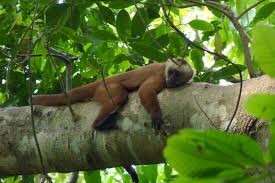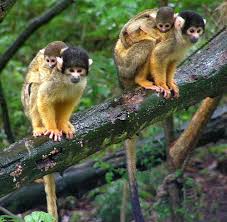
A Brown Capuchin lurking in the trees
Our Peruvian guide put his hand up, signalling us to stop, immediately we were all wide-eyed searching for what he had seen, heard, smelt or felt. Twinkles of light flushed through the canopy, but remained crystallised in position. Then one became blocked by a shadow, another tilted by moving branches. Speeding along was one- no two- no up to twenty squirrel monkeys. They squeaked excitedly among the trees, we were in awe. A different being then appeared, much larger and darker. Brown capuchins. These were far clunkier, contrasting greatly from the dance the squirrel monkeys performed. I couldn’t feel more privileged at that moment, in the Amazon forest, to witness not one but two, incredible species interacting.
However, seeing these two species together, Simia sciureus and Cebus apella, is not uncommon. In fact these two very different species form stable interspecific interactions and are seen to benefit from the presence ofthe other. These two species feed and travel together, even responding to one another’s alarm calls.
The true strangeness of the interaction comes when you witness the two species side by side. Brown capuchins are three times larger than squirrel monkeys, something which should make them appear threatening. What’s more is that capuchins are actually confirmed predators of the titi monkey, a monkey similar in size to the squirrels. And so we come to a scenario where squirrel monkeys could be potential prey to the capuchins; yet rather than the squirrels fleeing as soon as a capuchin is detected, or equally a capuchin obtaining an additional meal, the two live peacefully together.
So why do these two very different species live together? The combination of thirty odd squirrels and ten odd capuchins makes for a very large group storming through the forest; therefore we can look at advantages of large groups to answer this question. Larger groups result in reduced predation; which for these monkeys includes animals ranging from raptors and jaguars to snakes and caiman. There are three main reasons why large groups lead to reduced predation. Larger groups have more eyes to spot out a potential threat. Larger groups mean that there is a lower chance that a particular individual will be taken, due to there being multiple other individuals. And finally, larger group leads to something called the confusion effect; here a buzzling racket of squirrel monkeys and brown capuchins darting through the forest can confuse a predator of which prey to target, and decrease their success rate significantly. The commotion that the multiple monkeys cause bring us to another potential reason why the two species live together: food. As branches sway and snap from the monkeys movements it disrupts all kinds of insects making them fly up in despair, usually right into another monkey’s mouth.
These advantages of larger groups apply to a wide array of species. But if these were to be the only advantages to create this interaction, surely we would see interactions between many different primate species. There are many species of capuchin monkeys, so why do the squirrels pick the brown ones? Conversely there are many other small primates, so why do the capuchins pick the squirrels? It is a difficult question to answer and requires us to investigate specific traits that each species can provide to the other, which others cannot.
For brown capuchins, it may be their size which provides this specific trait. Brown capuchins being larger also means they are stronger, and so can crack open hard fruits and seeds that the squirrels cannot. As we all know primates are messy eaters, meaning that the squirrels can feast on the capuchins remains. However, studies have shown that this does not occur frequently enough to be the main reason for the interaction.
Perhaps exploring what the locals say about the capuchins may lead us to a more accurate answer. To the locals, the brown capuchins are the bullies of the forest. They will break branches and throw them at potential threats, one capuchin even urinated into eye of a volunteer. Therefore it appears that the squirrel monkeys could be exploiting the brown capuchins for their bodyguard-like traits. This seems plausible enough, but let us not forget the main confusion for the interaction in the first place: why capuchins should tolerate, and now guard, the squirrels when they could instead be feasting on them.
As we delve deeper into observational data we seem to find our answer. Squirrel monkeys are known for their large and dynamic groups, they will continuously disperse and search large areas of the forest, before regrouping to share information on the location of ripe trees. It is a highly effective system that leads to far more ripe trees being detected. What we observe when the squirrels are with the capuchins, is the capuchins taking their bully-like characteristics a step too far. Once a ripe tree is detected by the squirrels, the capuchins push their aggressive bodies around, leading to the squirrels being scared out of the tree and the capuchins consuming the ripe fruits. So perhaps we have been mistaken to call this interaction a positive one; perhaps instead the capuchins just follow the squirrels against their will, using them to find resources before then claiming them for themselves.
Fortunately, to avoid a depressing end, this does not appear to be the case. Studies show that the group size of squirrels correlates with that of capuchins, and vice versa – confirming that they must both benefit from the interaction. This allows us to conclude that perhaps for the squirrels the benefit of the bodyguard-like capuchins outweighs the loss of food. And for the capuchins, the increase in food resource from the squirrels’ knowledge outweighs what they could have gained from making them their prey.
Why are these interspecific interactions so important to forest life? The Amazon is known for supporting a wealth of biodiversity; such a wealth that it forces us to wonder how there are enough niches to accommodate all the species. A niche is not only the physical space a species occupies but also the role it carries out in the community, every species occupies its own niche. Therefore how can the Amazon provide enough niches for all the species that occupy it? Interspecific interactions can facilitate the competition for the limited amount of niches: rather than species competing for one niche they can share it instead. Layering species niches like this may provide us with evolutionary explanations for why so many species can coexist in one area. It is a phenomena which gives us the privilege of walking through the Amazon rainforest and encountering a huge spectrum of wondrous beings on the way.
![An Unlikely Friendship Our Peruvian guide put his hand up, signalling us to stop, immediately we were all wide-eyed searching for what he had seen, heard, smelt […]](/wp-content/uploads/2015/05/squirell-monkey-e1433537827847.jpg)
